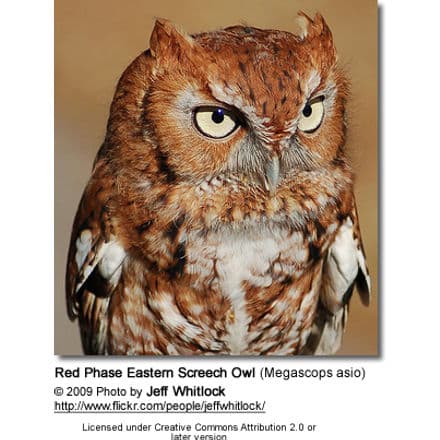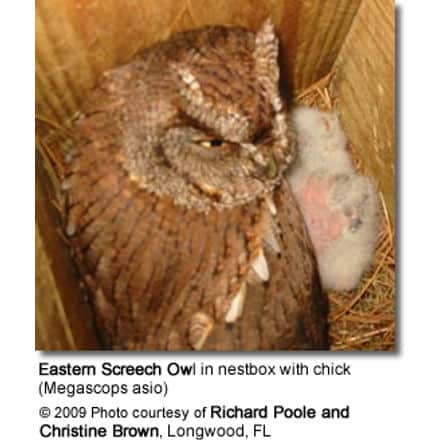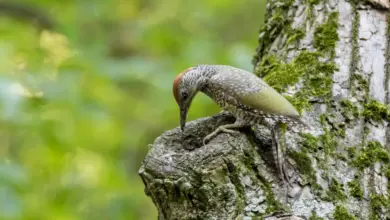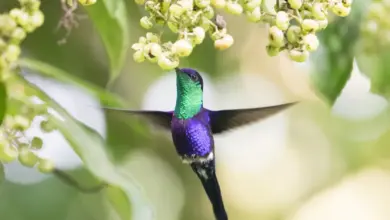Eastern Screech Owl (Megascops asio)
The Eastern Screech Owls (Megascops asio) are small owls that occur naturally in eastern North America and northeastern Mexico. They are relatively common and resident (non-migratory) throughout their large range.
The Eastern Screech Owl is one of the smallest species of owls naturally found in North America.
These nocturnal birds become active after sunset and silently hunt their prey at night. Both red morphs and grey morphs occur across the range.
Grey plumage birds are more common, and only about one-third are the red variant. The red morphs are more common in the East, with fewer than 15% red being found at the western edge of their range.
Eastern Screen Owls are also locally known by myriad names that were derived from their loud and occasional screeching calls, their physical description, habitats/range, or mystical associations (superstitions).
These local names include:
Common Screech Owls or simply Screech Owls, Mottled Owls, North American Screech Owls, Western Screech Owls, Shivering Owls, Little Horned Owls, Cat Owls, Mouse Owls, Red Owls, Little Grey Owls, Whickering Owls, Spirit Owls, Little-eared Owls, Ghost Owls, Spirit Owls, Dusk Owls, Little Dukelets, Demon Owls or Dusk Owls.
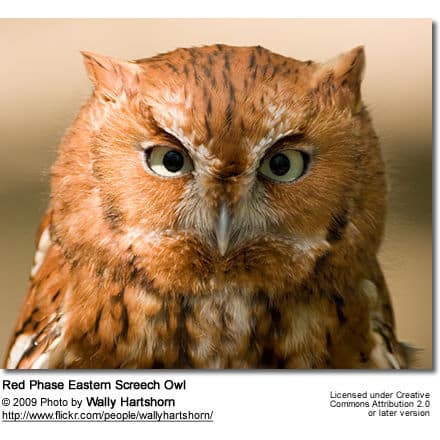
Distribution / Range
The Eastern Screech Owls are found in:
Canada:
- Southern Saskatchewan (south-central Canada) and adjacent southern Manitoba and southern Ontario and southwestern Quebec (western Canada).
United States
- Northern Minnesota and Michigan, and Maine; south through eastern Montana, eastern Colorado and Texas (along the Gulf Coast) to southern Florida.
- At their western range, they are the eastern front ranges of the Rocky Mountains in Wyoming, Montana, and Colorado.
Mexico
From the United States, their range extends south to central Nuevo Leon (northeastern Mexico), southern Tamaulipas and eastern San Luis Potosi.
Habitats
They inhabit open mixed woodlands, deciduous forests, isolated groves, wooded swamps / wetlands (particularly in drier areas). They are also commonly found in residential areas, orchards, parks and cemeteries with shade trees.
They typically avoid areas that are hunting grounds for the larger owls (particularly the Great Horned Owl).
During the day, these owls roost in natural cavities of large dead or living trees, in buildings or in the dense scrubby brush or foliage.
Eastern Screech Owl Range and Subspecies
Alternate (Global) Names
Chinese: ???? … Czech: Výrecek americký, výre?ek americký … Danish: Østamerikansk Dværghornugle … Dutch: Schreeuwuil … Finnish: Idänkirkupöllönen … French: Petit Duc Scops d’Amérique, Petit-duc maculé … German: Kreischeule, Ostkreischeule, Ost-Kreischeule … Italian: Assiolo americano orientale … Japanese: amerikaookonohazuku, higashiamerikaookonohazuku … Norwegian: Lundugle … Polish: syczek krzykliwy … Russian: ?????????????????? ?????, ???? ??????? ????? … Slovak: výrcek škriekavý, výr?ek škriekavý, Výrik škriekavý … Spanish: Autillo Chillón, Autillo de Chillón, Autillo Yanqui, Tecolote Oriental … Swedish: Östlig skrikdvärguv
Description
Eastern Screech Owls are compact in size and shape, measuring from 6.3 – 9.8 inches (16 – 25 cm) in length, including the short tail, and weighing about 4.3 – 8.6 oz (121 – 244 grams).
The females tend to be larger – with an average length of 9.2 inches (23 cm), a wingspan of 22 inches (56 cm) and weight of 7.3 oz (208 g).
The smaller males average 8.2 inches (21 cm) in length, have a wingspan of about 21 inches (54 cm) and weigh about 7 oz (200 g).
The head is large and round, with prominent, wide-set ear (feather) tufts. The eyes range in color from greyish-yellow to bright yellow. The bill ranges from greyish-yellowish / bone color to greyish-green at the tips with tufts of bristly feathers around the base.
There are two color morphs: a grey phase and a reddish-brown phase. The two color variants will mate together producing offspring with a brownish grey plumage. The plumage below is whitish patterned with streaks, offering them a perfect camouflage against the tree bark.
The reddish-brown variant is more common in the southern part of its range; and the pale grey variation occurs in western Canada and north-central United States.
Grey Phase:
- The facial disk is dusky white with fine grey-brown mottling, bordered by black.
- The plumage is overall dark grey or grey-brown, with grey narrow vertical stripes, bars and spots on underparts, and barred wings and tail.
Red Phase:
- The facial disk is a paler cinnamon; the upper plumage is rusty colored.
Similar Species
Eastern Screech-Owls resemble the Western Screech-Owls; but can be differentiated by the color of the bill. The Eastern Screech Owls have greyish-green bills while Western Screech Owls have bills that range in color from greyish to black. Their calls are also different. The ranges of these two screech owl species overlap only in eastern Colorado and southern Texas.

Diet / Feeding
The Eastern Screech Owls eat various larger insects, such as beetles, moths, crickets, grasshoppers and cicadas, which makes up more than half of their diet. They will also hunt small mammals, such as rodents, bats, shrews up to the size of rabbits; and birds ranging from chickadees, sparrows, warblers up to the size of a Ruffed Grouse (which are heavier than the screech owls). On occasion, they will also take earthworms, reptiles (small snakes, lizards even baby soft-shelled turtles), amphibians (frogs, toads, etc.) and small fish.
As is typical of owls, they are active at night or near dusk – with most hunting being done during the first hours of darkness. They use their excellent hearing and night vision to locate prey. They usually watch from a perch and swoop down when prey is spotted and seize their prey with their well-developed raptorial claws (talons). They are also capable of catching insects or small birds in flight.
During the winter, they have been observed hunting for fish at fishing holes or cracks in ice at bodies of water.
Smaller prey is usually swallowed whole on the spot; while larger prey is typically carried to the nests or roosting place where they use their claws and the curved bill to tear the prey into pieces that are small enough for them to swallow.
Every day, they expel about 2 – 4 medium-sized, compact, dark grey, oval pellets that are about 1.5 – 0.75 inches (3.8 – 1.9 cm) in diameter. These pellets are composed of indigestible parts of its prey – such as fur, feathers, bones, teeth and chitin.
Nesting / Breeding
The breeding season usually starts in mid-April – although may commence as early as mid-March – and stretches to mid- May.
The males select the nest sites, and the females select their mates based on the quality of the nest site or the amount of food the male placed into the nest.
Their courtship ritual is quite elaborate. It involves males approaching females and calling to them from different branches until they are close, at which point the males bobs and swivels his head, and then bobs his entire body.
Should the females be unreceptive, the male will intensify his bobbing and swiveling. If she is receptive, she will move closer to him until their bills touch and they start preening each other.
Pairs are monogamous, mating for life; however, they will accept a new mate if their previous mate disappears.
Males will defend small territories around their nest sites.
Screech owls typically nest in cavities of deciduous trees, such as oaks, elms, maples, sycamores, willows, apples and pines. These cavities are typically 6.5 – 20 feet (2 – 6 meters) above the ground, but may be situated as high as 50 feet (15 meters) above the ground. They may use the abandoned nests of other birds, such as woodpeckers.
In urban areas, they may also use suitable nest boxes or nest behind loose boards on abandoned buildings or barns.
They typically reuse the same nesting site year after year.
The average clutch consists of 3 – 5 eggs – although occasionally only two or up to 8 are laid. The female does most of the incubation (brooding of the eggs) which lasts about 26 days to hatching. The male is responsible for feeding the nesting female.
Once the young hatched, the female will tear food up into smaller sizes to feed to the young. Due to nest predation, only one young is likely to survive to fledging, which occurs about 31 days after hatching.
They usually only produce one clutch a season; but may produce a second, if the first clutch is lost.
Additional Resources
More Owl Information
- Owl Information
- Index of Owl Species with Pictures
- Owl Eyes / Vision Adaptations
- Pygmy Owls
- Barn Owls
- Horned Owls
- Scops Owls

